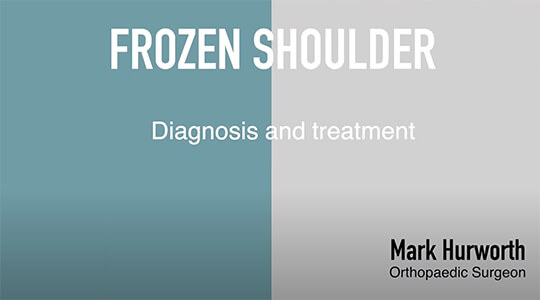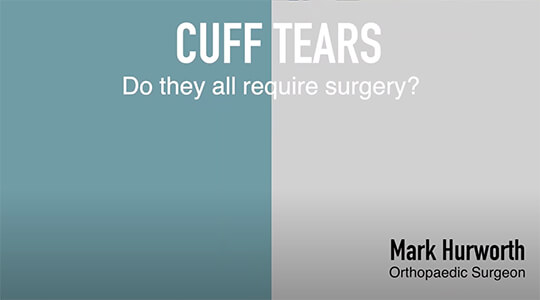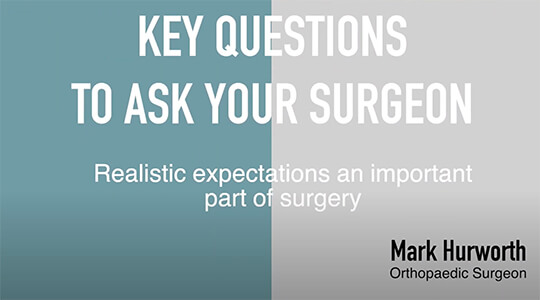Shoulder arthroscopy Perth
Shoulder arthroscopy - when is it necessary and what to expect?
Shoulder arthroscopy is a common procedure, used for a range of shoulder conditions. It normally involves clearing out (decompression) and repair of your tendons around the shoulder joint. Other common conditions treated are instability, long head of biceps pathology, calcific tendonitis and frozen shoulder (adhesive capsulitis).

My orthopaedic practice in a nutshell
When to have a shoulder arthroscopy?
What is a shoulder arthroscopy and when is it used?
The word arthroscopy comes from two Greek words: “arthro” (which means joint) and “skopein” (to look). Orthopaedic surgeons may recommend it to look inside your joint (both the glenohumeral or shoulder joint and the subacromial space).
Shoulder arthroscopy is used to treat conditions of the labrum (the lining of the joint which includes the origin of the biceps tendon), the rotator cuff or the subacromial space like supraspinatus tearing, impingement, calcific tendonitis and frozen shoulder (adhesive capsulitis).
We use this procedure because it gives us good access to the shoulder and – as with all arthroscopic procedures – it is less invasive than “open” surgery. Shoulder surgeons find it a simple and effective method to diagnose and treat shoulder conditions. Something to be aware of is that orthopaedic surgeons each have their preferred approach.

Mr Mark Hurworth, Shoulder surgeon Perth
With this surgery, there is some traction on your arm and generally, my patients have an interscalene block (a regional anesthetic) combined with a general anesthetic, to block sensation in your shoulder during and after surgery. Having a completely numb arm after surgery may feel a bit disconcerting when you wake up, but the effect generally disappears after about 12 hours. Most of these surgeries are done as day cases, ie in and out the same day.
Story continues below video gallery
Videos about shoulder conditions and surgeries
Shoulder arthroscopy for diagnosis & repair
What about the biceps?
If you have damage to or issues with the long head of the biceps, even MRI scans sometimes don’t give us the visual information we need to provide a clear diagnosis. That is when shoulder arthroscopy may be the best option to both diagnose and treat.
We call the biceps the ‘appendix of the shoulder’ because orthopaedic surgeons will agree that it seems to cause nothing but problems. The most common treatment for this type of condition is biceps tenodesis (we detach the biceps from the superior labrum, and re-attach it to the humeral head) and sometimes simply releasing the biceps (tenotomy).
In some cases, particularly in young athletes, we repair the superior labrum where the biceps attaches if it is torn (so-called SLAP repairs).
The majority of shoulder arthroscopies are used to treat subacromial impingement (pinching of the shoulder with overhead motion) and rotator cuff tearing. I perform almost all of my repairs arthroscopically.
Preparing for shoulder arthroscopy
How can I prepare?
When patients from Perth metro area come to see me at my practice at SJOG Murdoch, we have a chat about the importance of maintaining and regaining movement.

Mr Mark Hurworth, Shoulder surgeon Perth
“It is important to regain and maintain whatever motion you can. It doesn’t matter if it is after injury, before or after surgery.”
If you stop moving because it hurts, there will be stiffness and consequently muscle wasting. “Pain avoidance” behaviour, where fear of pain results in failure to move, will often make things worse. The shoulder can be extremely painful after injury or surgery, but this is one joint where pushing through the pain is often required.
So we do encourage you to move, and help you choose the right type of activities that support your muscles and get you in the best possible shape before your procedure.

Shoulder arthroscopy recovery
How do I optimise my recovery?
Here at my practice in Perth, we are working on new recovery techniques. We understand that when you have shoulder surgery, you want to get better quickly.
So we are trying hard to speed up rehabilitation for our patients after surgery. The core area of our research program in Perth currently focuses on knees, but we are always looking at ways to optimise recovery after shoulder surgery, with new techniques for remotely monitored exercises that we are designing and developing. In the interim, we are using the lessons from our rehabilitation programs in knee surgery to introduce good recovery habits for shoulder patients.
Typically, you will get instructions from our physiotherapist, either before or right after your operation. They will be personalised depending on your injury and your surgery, but there are some predictable elements of your recovery program – for example if you have had a rotator cuff repair:
- First, passive motion: you use the other (good) arm to move the operated shoulder. You use gravity and you protect any repairs.
- Then, active-assisted exercises: You start using a bit of muscle power in the shoulder that had surgery, but you assist with your other arm, sometimes using a pulley.
- And the next stage consists of full-active exercise.
My experience in shoulder surgery has emphasized that in general, healing for any tendon or ligament repair takes around 3 months. That is a reasonable target to reach good motion and functional strength. When we work together to give you a recovery program after major ligament or tendon surgery, we hold back on some strength work until you reach that 3-month mark.
The first goal is to allow your body to heal. Then we work on regaining motion. And lastly, we work on regaining strength.
Shoulder arthroscopy surgeon Perth
Why choose Mr Mark Hurworth in Perth?
When you chat to me about your shoulder, you can count on my expertise and experience as a surgeon. But equally, sometimes surgery is not the best option, and certainly with shoulders there is often a prolonged and painful recovery that make it important for you as the patient to be sure that you have exhausted nonoperative treatment, and have adequately prepared for surgery.
It is unusual to have a “quick fix” after shoulder surgery (though we are certainly getting quicker), and you need to understand the risks, and timeframes involved in recovery, before embarking on such surgery.


